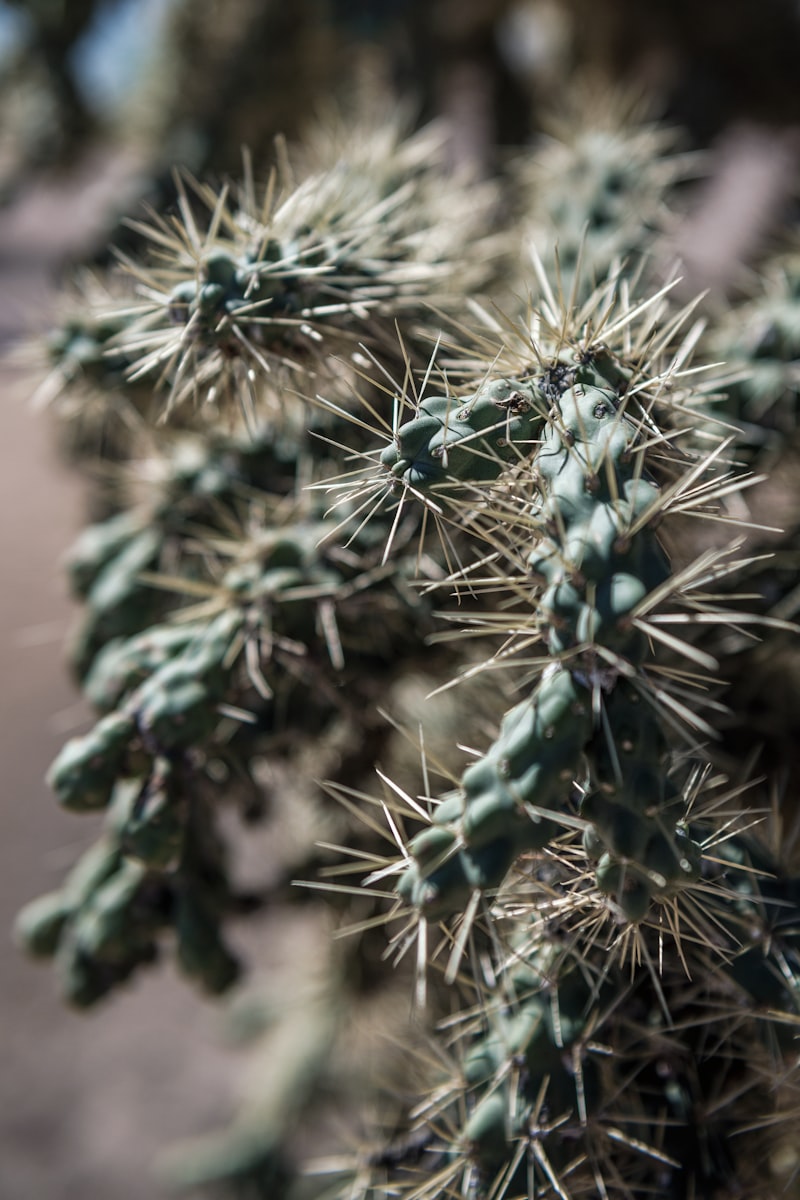Deserts are harsh and unforgiving environments, yet they are home to some of the most fascinating adaptations in the natural world. Plants and animals that thrive in deserts have evolved remarkable strategies to survive extreme heat, sparse water, and limited food sources.
Take the cactus, for example. These iconic desert plants have adapted to store water in their thick, fleshy stems. Their spines reduce water loss by shading the plant and creating a layer of still air around it. Some cacti, like the saguaro, can even expand like accordion bellows to accommodate water storage during rainy periods.
Animals in the desert have equally impressive adaptations. The camel, often called the “ship of the desert,” is known for its ability to survive long periods without water. Its hump stores fat, not water as commonly believed, which serves as an energy reserve when food is scarce. Camels also have thick coats that insulate them from the intense desert heat during the day and keep them warm at night.

Another fascinating example is the fennec fox, which has oversized ears that serve as radiators to dissipate heat and keep the animal cool. Its large ears also help in locating prey underground by amplifying faint sounds.
Desert plants and animals have evolved over millions of years to thrive in these challenging conditions. Each adaptation is a testament to nature’s ingenuity and the resilience of life itself.
Survival Strategies Unveiled: How Desert Animals Beat the Heat
In the blistering heat of the desert, where temperatures soar to staggering heights, survival isn’t just about finding water; it’s a masterclass in adaptation. Take the iconic camel, known as the “ship of the desert.” Its ability to survive for days without water stems from its unique physiology. Unlike other mammals, camels can tolerate a significant rise in body temperature and dehydration without compromising their health. Their humps are not water reservoirs as commonly believed but actually store fat, which provides energy when food and water are scarce.
Another desert dweller, the Fennec fox, has ears that are not just adorable—they’re incredibly functional. Those oversized ears aren’t just for show; they play a crucial role in dissipating excess body heat. By increasing the surface area exposed to the cool night air, these foxes can regulate their body temperature efficiently. It’s like having built-in air conditioning!
Moving to the ground, the Saharan silver ant has mastered the art of sprinting across scorching sand. Clocking in at speeds of up to 3 feet per second, these ants perform a mesmerizing dance across the desert floor to avoid getting toasted by the sun. Their silver sheen reflects sunlight, reducing heat absorption, while their long legs keep them above the searing sand.
Then there’s the resilient desert tortoise, a true marvel of endurance. These creatures can survive in some of the hottest and driest places on Earth by burrowing underground during the day to escape the heat. Their thick, scaly skin helps retain moisture, and they have adapted to store water in their bladders for long periods, minimizing their need to drink.
Each of these animals has evolved over millennia, fine-tuning their strategies to cope with the extreme conditions of the desert. From anatomical adaptations to behavioral tricks, they showcase nature’s ingenuity in the face of adversity. Next time you marvel at a desert landscape, remember the incredible survival stories unfolding right under the blazing sun.
Ingenious Solutions: How Desert Plants Thrive with Little Water
One of the most striking features of desert plants is their ability to store water efficiently. Take the iconic saguaro cactus, for example, whose accordion-like pleats expand and contract to accommodate varying water levels. This mechanism not only helps the cactus retain water during dry spells but also prevents it from bursting when rain finally arrives after a long drought.

Moreover, desert flora often feature specialized root systems that delve deep into the earth in search of water sources. These roots can extend far beyond the plant’s visible reach, tapping into underground reservoirs or exploiting shallow pockets of moisture that escape the harsh sun’s grasp.
Another ingenious adaptation is the development of thick, waxy coatings on the plant’s surface, known as cuticles. These cuticles serve as natural barriers, reducing water loss through evaporation and protecting the plant from intense solar radiation. Some plants, like the desert lavender, even have small hairs on their leaves that create a microclimate, trapping moisture and shielding against excessive heat.
Furthermore, many desert plants have evolved to perform photosynthesis at night rather than during the day. This nocturnal strategy, as seen in certain species of cacti and succulents, allows them to open their stomata (tiny pores on leaves) when temperatures are cooler and humidity is higher, minimizing water loss while maximizing carbon dioxide uptake.
In essence, the survival tactics of desert plants offer a fascinating glimpse into evolutionary prowess. Their ability to thrive in extreme environments underscores nature’s ability to innovate under pressure, providing valuable insights into sustainable living and resource management for human societies facing water scarcity challenges worldwide.
Secrets of Resilience: The Evolutionary Wonders of Desert Creatures
One of the most remarkable adaptations of desert creatures is their ability to conserve water. Take the iconic camel, known as the “ship of the desert,” with its hump storing fat, not water as often thought, allowing it to survive for weeks without drinking. Similarly, the kangaroo rat of North American deserts hardly ever drinks water, obtaining sufficient moisture from the seeds it consumes.
Another evolutionary marvel is the camouflage techniques desert creatures employ. The sand-colored coat of the fennec fox blends seamlessly with its arid surroundings, providing it with effective camouflage against predators. The thorny devil, native to Australian deserts, not only blends in with the sandy terrain but also has a unique defense mechanism—its skin can change color to regulate body temperature.
Endurance under extreme temperatures is another feat mastered by desert dwellers. The sidewinder rattlesnake moves across scorching sands using a distinctive sidewinding motion, minimizing contact with the hot surface. Meanwhile, the Saharan silver ant has adapted to withstand temperatures nearing 130°F (54°C) by foraging during the hottest part of the day when other predators are less active.
Desert creatures also exhibit remarkable behavioral adaptations. The meerkat, a social mongoose species found in African deserts, lives in tight-knit groups where individuals take turns standing guard against predators while others forage for food. This cooperative behavior enhances their survival chances in a harsh environment.
The secrets of resilience displayed by desert creatures are a testament to the wonders of evolution. Their ability to survive and thrive in some of the planet’s most inhospitable environments serves as an inspiration, reminding us of the incredible adaptability of life itself.
Extreme Makeover: How Desert Animals Adapt to Scorching Environments
Ever wondered how desert animals survive in blistering hot environments? It’s truly remarkable how they’ve adapted to thrive where many would struggle to survive. From scorching days to freezing nights, these creatures have evolved ingenious ways to conquer the desert’s challenges.
One of the most striking adaptations is seen in the dromedary camel. This “ship of the desert” sports a coat of coarse fur that not only insulates it from the searing heat but also reflects sunlight away. Their nostrils can close to keep out blowing sand, while their humps store fat—not water as commonly thought—which serves as an energy reserve when food and water are scarce.
Then there’s the Saharan silver ant, a tiny marvel that braves temperatures upwards of 120 degrees Fahrenheit. Unlike most ants, these silvery insects aren’t seeking food during the day; they’re racing to collect it. Their silver sheen deflects sunlight, and their long legs keep their bodies far above the scorching ground. These adaptations help them evade predators and gather food efficiently.
Speaking of predators, the fennec fox has adapted uniquely to the desert. With oversized ears that radiate excess heat and help detect prey underground, these pint-sized foxes are perfectly suited to their arid home. They can survive without drinking water for extended periods by obtaining moisture from their food—a skill that’s invaluable in such a parched environment.
Another desert expert is the sidewinder rattlesnake. Instead of slithering across scalding sands, it uses a distinctive sidewinding motion, which reduces the amount of body touching the hot ground at any one time. This movement also leaves a minimal trail for potential predators to follow, ensuring its survival in the harsh desert conditions.
These examples illustrate just a fraction of the incredible adaptations that desert animals have developed. Each species has honed specific traits over generations to withstand the extreme heat, scarce water, and relentless sun of their desert habitats. It’s a testament to the resilience and diversity of life, showing how nature continually surprises us with its solutions to the challenges it faces.
Frequently Asked Questions
What are some adaptations of desert plants to survive harsh conditions
Learn about the adaptations of desert plants that help them survive harsh conditions, including specialized root systems for water absorption, reduced leaf surface to minimize water loss, and mechanisms to store water efficiently.
How do desert plants prevent water loss
Desert plants prevent water loss through various adaptations such as deep root systems to access underground water, thick cuticles on leaves to reduce evaporation, and CAM photosynthesis which allows them to open their stomata at night to conserve water.
What are examples of behavioral adaptations in desert animals
Learn about behavioral adaptations in desert animals, including examples like nocturnal activity to avoid daytime heat, burrowing to escape extreme temperatures, and seeking shade during the hottest hours. These adaptations help desert animals survive in their harsh environment.
Why are camels well-adapted to desert environments
Camels are well-adapted to desert environments due to their specialized physiological features such as efficient water conservation, ability to withstand extreme temperatures, and unique adaptations in their metabolism and behavior.
How do desert animals conserve water in their habitats
Learn how desert animals conserve water in their habitats through adaptations such as minimizing water loss through urine and feces, storing water in their bodies, and adjusting their behavior to avoid heat during the day.



